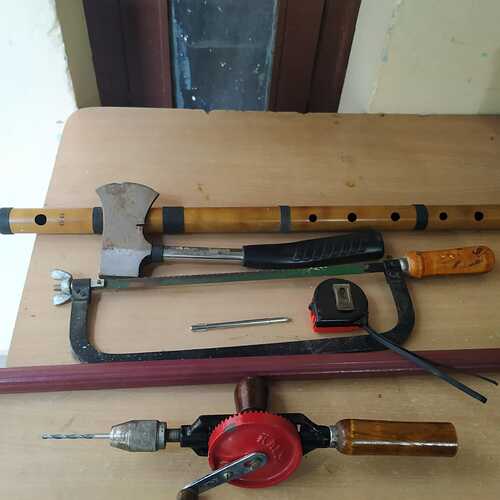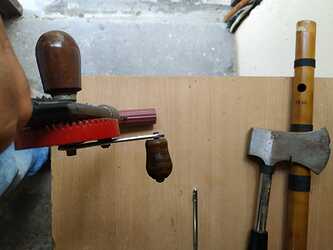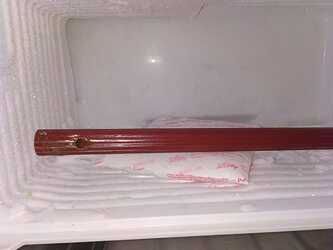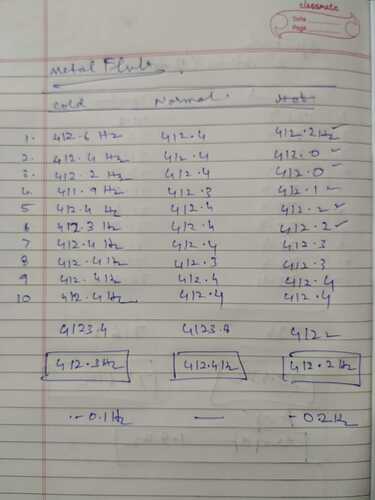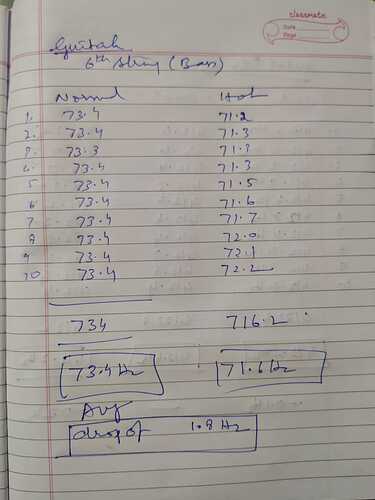The present experiment was prompted by @ravi312 who asked certain questions regarding effect of various conditions on the pitch of a flute made out of a straw or paper.
However, I thought of creating this thread to share my experimental observations (not very scientific though) with other and prompt them to do something similar which could help us to come to a conclusion.
[center]“DON’T TRY THIS WITHOUT ADULT SUPERVISION”[/center]
The Experiment
Aim: To prove the assumption that thermal expansion would affect the pitch of Guitar more as compared to a Bamboo Flute and a homemade Steel Flute.
Apparatus: A Guitar, a Bamboo Flute, a homemade Steel Flute, some clay, a mobile phone, a hammer, a screwdriver, a hand drill, a steel pipe to make the steel flute, a measuring tape, a hacksaw and a hair dryer.
Some of the apparatus. Though the Axe has been put there for dramatic effect only
Apps used:
gStrings – for measuring the pitch of the guitar.
Frequency Counter – for measuring the pitch of the Bamboo as well as the Steel Flutes.
Procedure:
First, Make a Steel Flute.
- Cut the steel pipe into a 15-inch section (so that it could fit in a freezer, if you have a bigger/smaller freezer you can increase or decrease accordingly).
- Drill a hole about 5-6 mm in diameter 1 inch from one end using a hand drill. Please don’t use a power drill. Its RPM might be just too high. Alternately you can make this hole using a screwdriver as well.
- Block the passage of air at the side of the hole just made by using clay.
- Viola! Your flute is ready. No other holes are required as we have to test the flute at one pitch only. Other holes may lead to leakages and possibility of errors.
Now the fun part:
-
Put the Steel Flute in a freezer. Don’t put the guitar or the bamboo flute . They might be permanently damaged. The handmade flute can be abused and cooled or heated (that was the very purpose of making it!).
-
Take the guitar, open gStings app on the mobile and measure the pitch of the thickest string of the guitar at room temperature. Take at least 10 readings and record these in a tabular form.
-
Now, carefully heat the thickest string of the guitar using a hair dryer open gStings app on the mobile and measure its pitch while it’s still warm. Take at least 10 readings and record these in a tabular form.
-
Take the Bamboo Flute, cover all the holes, blow from the mouth piece. Measure the pitch using Frequency Counter app. Take at least 10 readings and record these in a tabular form.
-
Carefully heat the bamboo flute while trying not to damage it. Measure the pitch using Frequency Counter app. Take at least 10 readings and record these in a tabular form.
-
Now take out the handmade steel flute from the freezer.
-
Take the Steel Flute, blow from the mouth piece. Measure the pitch using Frequency Counter app. Take at least 10 readings while it’s still freezing cold and record these in a tabular form.
-
Wait for some time and let the Steel Flute come to room temperature. Blow from the mouth piece. Measure the pitch using Frequency Counter app. Take at least 10 readings and record these in a tabular form.
-
Now using a hairy dryer carefully heat the Steel Flute while ensuring that you don’t heat the mouth piece too much otherwise it may result in an injury. Blow from the mouth piece. Measure the pitch using Frequency Counter app. Take at least 10 readings and record these in a tabular form.
-
Now analyze the data.
Data:
Bamboo Flute:
Steel Flute:
Guitar:
Findings:
Bamboo Flute: Hardly any noticeable change in the pitch. Just a drop of 0.1 Hz only.
Steel Flute: Marginal change in the pitch. It’s so minute it cannot be perceived by the human ear. A drop (instead of increase which it should have) of 0.1 Hz while frozen and a drop of 0.2 Hz when heated.
Guitar: Clear change in the pitch. A drop of almost 2 Hz. It may not be perceived by an average person but an average guitarist or any average musician can easily tell the difference.
Q.E.D. Thermal expansion will have more effect on a stringed instrument that a Straw/Bamboo/Steel Flute.
Possible Errors:
- Temperature was not accurately measured. It has been described as NORMAL, HOT or simply FREEZING, which, by the way, is not very scientific.
- In case of the Steel Flute the is a marginal drop in the pitch instead of the expected increase in the pitch while it has been frozen. It could be due to the different thermal properties of the steel used and the clay used to block one end.
Important Notes:
“DON’T TRY THIS WITHOUT ADULT SUPERVISION”
Pics & Videos and Assisted by: : Miss Pritika Siyan @Pritika
